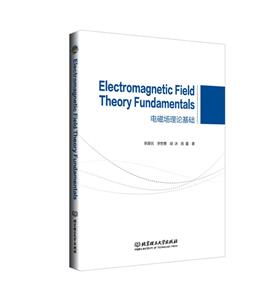-
>
宇宙、量子和人類心靈
-
>
氣候文明史
-
>
南極100天
-
>
考研數學專題練1200題
-
>
希格斯:“上帝粒子”的發明與發現
-
>
神農架疊層石:10多億年前遠古海洋微生物建造的大堡礁
-
>
聲音簡史
電磁場理論基礎 版權信息
- ISBN:9787576307030
- 條形碼:9787576307030 ; 978-7-5763-0703-0
- 裝幀:一般膠版紙
- 冊數:暫無
- 重量:暫無
- 所屬分類:>
電磁場理論基礎 本書特色
電磁場理論是現代電子技術的基礎課程,其應用遍及整個國家經濟,在各個領域中具有廣泛的應用。本書主要介紹了普物電磁學、靜態場的邊值問題、宏觀電磁理論、平面電磁波的傳播性質及其在邊界面上的反射、折射和導行電磁波等。學習本書對培養學生嚴謹的科學作風、抽象思維能力及科學的創新精神起到非常重要的作用。
電磁場理論基礎 內容簡介
電磁場理論是現代電子技術的基礎課程,其應用遍及整個國家經濟,上至天文,下至地質,涵蓋了工業、農業、軍事、醫學和環境保護等各個領域,即使飲食、家電等生活方面也得到廣泛應用。沒有電磁波的發射、傳輸和接收,就不會有電視、通信、雷達、遙感、測控和電子對抗等等。電磁理論也是許多交叉學科的孕育點,學習電磁場理論對培養學生嚴謹的科學作風、抽象思維能力及科學的創新精神起到非常重要的作用。深厚的電磁理論是欲在電子技術領域有所作為者不可少缺的功底。 電磁場理論的講述無非是“從一般到特殊”和“從特殊到一般”兩種途徑,對不同讀者兩者各有其優點。根據作者二十余年講授本課程的體會,在課程系統的總體安排上,按“從特殊到一般”的循序漸進方式,有利于初學者對本課程的理解;而講授具體問題時,采用從“一般到特殊”的方法,則可以節省學時且理論上較為嚴謹。 本教材共分十章,**章矢量分析作為學習電磁場理論的必要數學工具,強調了各種坐標系描述物理關系的一致性及三種主要坐標系的相互關系和場論基礎。第二、三、四、六章為靜電場、恒定電場、恒定磁場和電磁感應,涵蓋了普物電磁學的全部內容,統一了普物電磁學和電磁場兩種描述方法。第五章靜態場的邊值問題側重于分離變量法和鏡像法,以有限差分法為例說明數值法在解決復雜邊值問題時的重要性。第七章時變電磁場總結了宏觀電磁理論,引出麥克斯韋方程組,討論能流密度概念為電磁波的論敘奠定基礎。第八章較詳細地論敘了平面電磁波的傳播性質及其在邊界面上的反射、折射,并對損耗媒質中的傳播作了簡要介紹。第九章導行電磁波討論了導行波的基本原理和處理導行波的基本方法。第十章輻射討論電磁能量的輻射原理,簡介了基本輻射天線。
電磁場理論基礎 目錄
Chapter 1 Vector Analysis
§ 1. 1 Vector Function and Vector Operations
§ 1. 2 Cartesian Curvilinear System
§ 1. 3 Gradient, Divergence, and Curl
§ 1. 4 Several Important Vector Fields
§ 1. 5? δ Function, Green??s Theorem, and Helmholtz Theorem
Chapter 2 Electrostatics
§ 2. 1 Charge and Charge Density
§ 2. 2 Coulomb??s Law
§ 2. 3 Electric Field and Electric Field Intensity
§ 2. 4 Electric Field Line and Electric Flux
§ 2. 5 Gauss??s Law
§ 2. 6 Electrostatic Field Loop Theorem
§ 2. 7 Electric Potential and Potential Difference
§ 2. 8 Poisson??s and Laplace??s Equation of Electric Potential
§ 2. 9 Electric Dipole
§ 2. 10 Electrostatic Field in Dielectrics
§ 2. 11 Conductors in Electrostatic Field
§ 2. 12 Energy and Force of Electric Field
§ 2. 13 Capacitor
Chapter 3 Steady Electric Field and Current
§ 3. 1 Current and Current Density
§ 3. 2 Fundamental Laws of Steady Current Field
§ 3. 3 Power Source and Electromotive Potential
§ 3. 4 Ohm??s Law and Joule??s Law
§ 3. 5 Boundary Condition of Steady Current Field
§ 3. 6 Comparison Between Steady Current Field and Electrostatic Field
Chapter 4 Magnetostatic Field
§ 4. 1 Magnetic Force and Magnetic Field Intensity
§ 4. 2 Motion of Charged Particle in Magnetic Field
§ 4. 3 Ampère??s Magnetic Force Law and Biot?Savart??s Law
§ 4. 4 Fundamental Laws of Steady Magnetic Field
§ 4. 5 Vector and Scalar Magnetic Potentials
§ 4. 6 Magnetic Dipoles
§ 4. 7 Magnetization of Magnetic Media
§ 4. 8 Fundamental Laws of Magnetic Field in Magnetic Media
§ 4. 9 Ferromagnetic Media
§ 4. 10 Boundary Conditions on Magnetic Media Interface
Chapter 5 Boundary Value Problems of Static Fields
§ 5. 1 Uniqueness theorem and Principle of Superposition
§ 5. 2 Separation of Variables of Laplace Equation
§ 5. 3 The Method of Images
§ 5. 4 Complex Analysis
§ 5. 5 Finite Difference Method
Chapter 6 Electromagnetic Induction
§ 6. 1 Faraday??s Law
§ 6. 2 Generalization of Faraday??s Law
§ 6. 3 Inductance
§ 6. 4 Energy in Magnetic Field
Chapter 7 Time Varying Electromagnetic Field
§ 7. 1 Displacement Current and Generalized Ampère??s Law
§ 7. 2 Maxwell??s Equations
§ 7. 3 Time Harmonic Electromagnetic Field
§ 7. 4 Dispersion and Loss
§ 7. 5 Poynting??s Theorem
§ 7. 6 Wave Equation of Electromagnetic Field
§ 7. 7 Scalar and Vector Potential
§ 7. 8 Boundary Condition of Time Varying EM Field
Chapter 8 Plane Wave
§ 8. 1 General Solution of Helmholtz Equation
§ 8. 2 Uniform Plane Wave in Ideal Media
§ 8. 3 Polarization of Electromagnetic Wave
§ 8. 4 Uniform Plane Wave in Conductive Media
§ 8. 5 Phase Velocity and Group Velocity
§ 8. 6 Reflection and Transmission of Electromagnetic Wave on Ideal Media Interface
§ 8. 7 Total Transmission and Total Reflection
§ 8. 8 Reflection and Transmission of Lossy Media Interface
§ 8. 9 Reflection and Transmission in Multilayer Media
Chapter 9 Guided Electromagnetic Wave
§ 9. 1 Electromagnetic Fields of Guided Waves
§ 9. 2 Rectangular Waveguide
§ 9. 3 TE10 Mode
§ 9. 4 Energy Transmission and Losses in Waveguide
§ 9. 5 Circular Waveguide
§ 9. 6 TEM Wave on Transmission Lines
§ 9. 7 Cavity Resonators
Chapter 10 Radiation of Electromagnetic Wave
§ 10. 1 Retarded Potential
§ 10. 2 Radiation of Hertzian Dipole
§ 10. 3 Radiation of Magnetic Dipole Antenna
§ 10. 4 Line Antennas
§ 10. 5 Directivity and Gain
§ 10. 6 Antenna Array
電磁場理論基礎 作者簡介
李厚民,博士,教授級高級工程師,籍貫湖北荊門。2005年清華大學材料科學與工程系學士,2006年美國南加州大學材料科學與工程系碩士,2008年美國奧本大學高分子與纖維工程系碩士,2011年,美國奧本大學電子與計算機工程系碩士,2011年,美國奧本大學高分子與纖維工程系博士。攻讀學位期間曾擔任電磁場理論、通信系統實驗、線性信號與系統課程助教講師,并獲得校企聯合培養機會,在美國蕭氏工業集團(福布斯500強,巴菲特控股)任職1年,在美留學期間曾參與多項重點科研項目。2011年博士畢業后回國,任教于北京理工大學信息與電子學院,主講電磁場理論及微波工程基礎等課程。長期從事電磁材料與結構,低損耗超寬帶微波毫米波結構與器件,微波毫米波電路先進制造技術等領域的教學與研究工作。出版學術專著1部,發表SCI/EI檢索論文20余篇,授權發明專利20余項。
- >
隨園食單
- >
上帝之肋:男人的真實旅程
- >
姑媽的寶刀
- >
伯納黛特,你要去哪(2021新版)
- >
苦雨齋序跋文-周作人自編集
- >
唐代進士錄
- >
【精裝繪本】畫給孩子的中國神話
- >
朝聞道
















